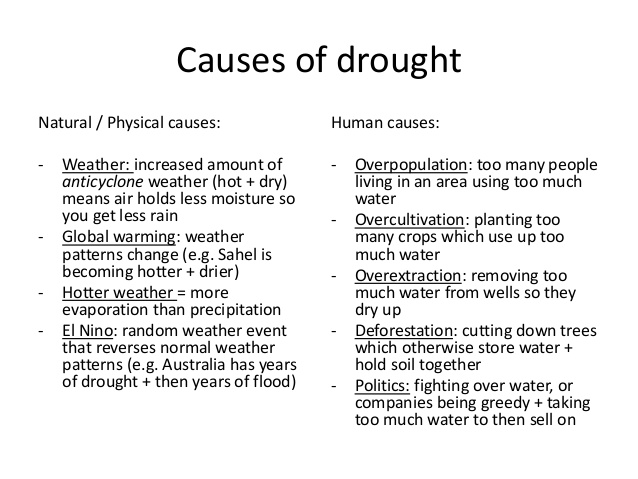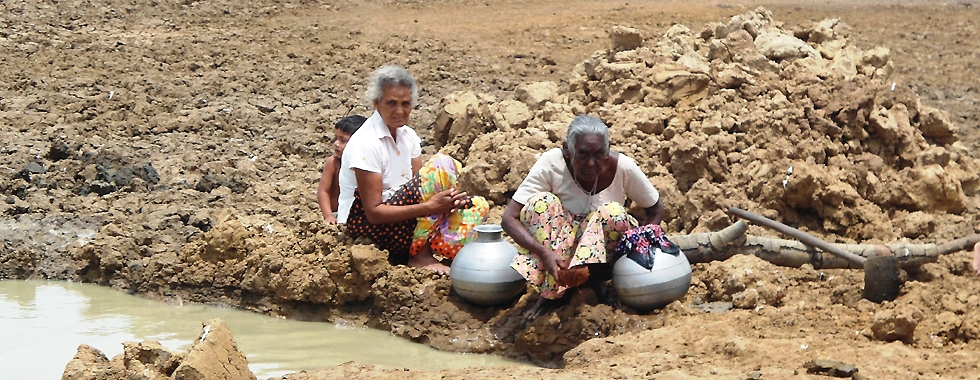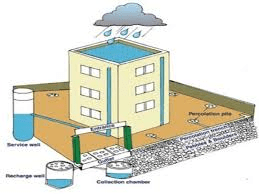Drought for Children
This section is aimed at younger minds (and their educators) to enable them to learn about disasters, impacts and its management.
What is a Drought ?

Drought is a natural hazard such as like cyclones, earthquakes, floods, tsunami and lightning. When an area continuously has unusually dry weather and it receives very small amounts of rain in relation to what is typical, meteorologists call that situation a Drought. During hot weather there can be a lot of evaporation from water surfaces and evapotranspiration from vegetation. Springs can dry run and water storage such as in reservoirs and tanks. Water managers or Hydrologists identify a Drought as one where there is scarcity of water for humans and the ecosystem. Farmers shall identify a drought as one where they do not have adequate water for the crops. Ultimately, people decide what a drought is depending on how it impacts them.
What is the pattern of rainfall in Sri Lanka?
Sri Lanka receives on average about 1850 millimeters of rainfall annually – this can vary between 600 mm in some areas such as Mannar and Hambantota to 5500 mm around Watawala. The global average of annual rainfall over land is around 750 mm – thus even though Sri Lanka has relatively high rainfall, the uneven distribution and the very high density of people leads to drought. Seasonally, most of Sri Lanka have very low rainfall between January to April and June to August – the exception is the Southern and Western slopes and coasts of our hills from June to August. The North-East slopes have higher rainfall from December to January and the North-East coasts obtain more rainfall than the rest of the country through storms from November to January.
What are the causes for a Drought ?

Source : https://www.slideshare.net/geodebs/drought-8081937
Droughts can be caused by natural as well as human phenomenon.
Natural events such as lack of rainfall, surface water flow and rising temperature can reduce the water present for human activities and agriculture. This will make a situation where less than expected water is to be used for necessary purposes. Therefore, a Drought situation can arise. This is also closely tied to the water cycle as it is the main feature through which we receive water. If that is not normal or disruptive Drought conditions will prevail.
Humans also play a major role in the causes of Drought. One of these actions if deforestation or the destroying of forests. As forests are key for water conservation deforestation makes water retention very hard and make water scarce. Another factor that contributes towards Drought if global warming. This is made possible by the actions of burning more fuel and release of gases called greenhouse gases which are harmful to the atmosphere. Through these the temperature of the earth will increase making it disrupt the natural environment and this causes Drought conditions.
How does a Drought affect us?
Droughts affect us and the environment in many ways. It is because Droughts are connected with times of less water. As we know humans, animals and plants all need water to survive. We also need water to generate electricity and for use in industries such as agriculture. And most importantly we need it for drinking, cleaning and cooking.
The possible public health implications of drought include:
- Compromised quantity and quality of drinking water
- Increased recreational risks
- Effects on air quality
- Diminished living conditions related to energy, air quality, and sanitation and hygiene
- Compromised food and nutrition
- Increased incidence of illness and disease.

Source : http://www.sundaytimes.lk/140803/news/families-animals-suffer-in-a-parched-land-109503.html
Can we protect ourselves from Drought ?
Droughts remain for longer periods of many months and even years. It is difficult to predict when a Drought will arrive and when it will be over with certainty – still in this portal we shall provide predictions for drought which while not perfect still has much better odds than guessing. We have specialists such as scientists who study the climate, water, economy and society who inform us how to prepare to mitigate and adapt during a Drought. Much of this work of mitigation and adaptation must be done before a Drought situation. These can be building dams, conserving forests and water sources, reusing and recycling water, storing water, prevention of pollution and rainwater harvesting systems. At the beginning of a drought steps can be taken to reduce water use through choice of less water intensive crops such as rice, providing replenishment of water for wildlife water, and through conservation campaigns.
What is Rainwater Harvesting?
Find the link for Rainwater Harvesting
Rainwater Harvesting is method to collect and store rainwater into naturally built tanks. It may also mean the collection of surface water into an aquifer as shown below.

Source : https://en.wikipedia.org/wiki/Aquifer
Another method of RWH is rooftop harvesting. For this any surface like metal sheeps or plastic could be used. However, grass or other natural absorbents are not applicable. Such storing will provide water yearlong for all water related activities.

RWH system consists of a collector, storage system and conveyances of water. The size of the collector and the size of the storage tanks are pivotal. The storage should be sufficient to help families tide over dry spells. The collector should be sufficient to harvest adequate volumes during the rain spells.
